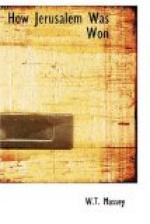The loss of Beersheba was a heavy blow to the Turk. Yet he did not even then realise to the full the significance of our capture of the town. He certainly failed to appreciate that we were to use it as a jumping-off place to attack his main line from Gaza to Sheria by rolling it up from left to right. In this plan there is no doubt that General Allenby entirely deceived his enemy, for in the next few days there was the best of evidence to show that General Kress von Kressenstein believed we were going to advance from Beersheba to Jerusalem up the Hebron road, and he made his dispositions to oppose us here. It was not merely the moral effect of the loss of Beersheba that disturbed the Turks; they had been driven out of a not unimportant stronghold.
All through the many centuries since Abraham and his people led a pastoral life near the wells, Beersheba had been a meanly appointed place. There were no signs as far as I could see of any elaborate ruins to indicate anything larger than a native settlement. Elsewhere we saw crumbling walls of ancient castles and fortresses to tell of conquerors and glories long since faded away, of relics of an age when great captains led martial men into new worlds to conquer, of the time when the Crusading spirit was abroad and the flower of Western chivalry came East to hold the land for Christians. Here the native quarter suggested that trade in Beersheba was purely local and not ambitious, that it provided nothing for the world’s commerce save a few skins and hides, and that the inhabitants were content to live the rude, simple lives of their forefathers. But the enterprising German arrived, and you could tell by his work how he intended to compel a change in the unchanging character of the people. He built a handsome Mosque—but before he was driven out he wired and mined it for destruction. He built a seat of government, a hospital, and a barracks, all of them pretentious buildings for such a town, well designed, constructed of stone with red-tiled roofs, and the gardens were nicely laid out. There were a railway station and storehouses on a scale which would not yield a return on capital expenditure for many years, and the water tower and engine sheds were built to last longer than merely military necessities demanded. They were fashioned by European craftsmen, and the solidity of the structures offered strange contrast to the rough-and-ready native houses. The primary object of the Hun scheme was, doubtless, to make Beersheba a suitable base for an attack on the Suez Canal, and the manner of improving the Hebron road, of setting road engineers to construct zigzags up hills so that lorries could move over the road, was part of the plan of men whose vision was centred on cutting the Suez Canal artery of the British Empire’s body. The best laid schemes....




